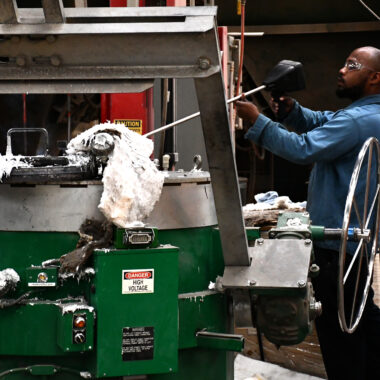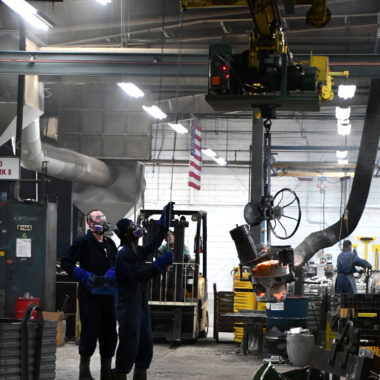About Aluminum Casting Chronicles: Strategies, Patterns, and Tips
About Aluminum Casting Chronicles: Strategies, Patterns, and Tips
Blog Article
Light Weight Aluminum Spreading Proficiency: Strategies and Devices for Remarkable Results
Mastering the art of aluminum casting calls for a fragile equilibrium of accuracy, strategy, and the use of specialized devices. From the first stages of thawing the light weight aluminum to the complex process of mold preparation and putting, each action plays a critical duty in accomplishing outstanding outcomes. As we explore the intricate techniques and tools entailed in light weight aluminum casting mastery, one can not overlook the value of innovative putting and cooling methods that can boost the final outcome. Keep tuned to reveal the necessary tools and finishing touches that lead the way for remarkable aluminum castings.

Relevance of Correct Melting Techniques
Utilizing precise temperature control during the melting process is vital in making certain the quality and integrity of light weight aluminum castings. The melting of aluminum is a crucial action in the casting process, as it straight influences the last residential or commercial properties of the casted parts. Proper melting techniques are necessary to achieve the wanted metallurgical framework, mechanical properties, and surface area coating of the aluminum components.

Furthermore, monitoring and readjusting the thaw temperature level during the process help avoid overheating, which can trigger grain development and influence the overall top quality of the aluminum spreading. Abiding by specific melting strategies not just boosts the top quality of the end product yet also improves the efficiency and cost-effectiveness of the casting procedure.
Essential Mold Prep Work Steps
Correct preparation of molds is a basic aspect in the light weight aluminum spreading process, ensuring the effective replication of detailed details and measurements in the last casted components. Prior to putting the molten light weight aluminum, the mold dental caries should be carefully cleansed and dried to protect against problems in the spreading.
Additionally, correct gating and risering layout are important in mold and mildew preparation to make sure sound spreadings with marginal issues like porosity and shrinkage. Eviction system facilitates the flow of liquified metal into the mold tooth cavity, while risers help avoid contraction by offering additional liquified steel as the casting strengthens. Careful factor to consider of these elements during mold and mildew preparation substantially adds to the quality and stability of the last aluminum cast elements.
Advanced Pouring and Air Conditioning Methods
Carrying out innovative pouring and cooling approaches is pivotal in optimizing the aluminum casting process for improved performance and top quality outcomes. Using methods such as vacuum cleaner spreading can dramatically reduce porosity in the final product, causing enhanced mechanical residential or commercial properties. By leaving the air from the mold and mildew tooth cavity prior to putting, the risk of gas entrapment is minimized, resulting in a denser and more structurally sound casting.
Additionally, utilizing regulated cooling techniques, such as water quenching or air cooling, can influence the material's microstructure and mechanical characteristics (about aluminum casting). Fast cooling can help achieve finer grain structures and boosted mechanical residential or commercial properties, making the cast aluminum much more suitable for applications requiring high toughness and resilience
Furthermore, applying directional solidification methods, where the casting strengthens gradually from one end to another, can aid alleviate interior problems and boost general part honesty. By very carefully managing the temperature level differentials throughout solidification, the formation of contraction porosity and hot rips can be reduced, leading to better spreadings with enhanced mechanical efficiency.
Vital Devices for Aluminum Spreading
Enhancing the effectiveness and top quality results of light weight aluminum casting procedures relies greatly on the usage of specific devices made to enhance numerous aspects of the spreading procedure. One necessary tool for light weight aluminum spreading is the crucible. Crucibles are containers made of products like clay-graphite or silicon carbide that hold up against the heats needed for melting aluminum. Crucibles are available in numerous sizes to fit various spreading volumes and are critical for melting and pouring the molten light weight aluminum.
One more indispensable tool is the mold. Molds can be made from materials like plaster, sand, or steel and are used to shape the molten aluminum into the desired type. about aluminum casting. Appropriate mold and mildew layout and products are essential for achieving precise casting dimensions and surface finishes
In addition to crucibles and molds, a furnace is a fundamental tool for aluminum casting. Furnaces heat the steel to its melting factor, guaranteeing it remains in a state all set for spreading. Vital for keeping constant temperatures and guaranteeing the aluminum stays liquified, heating systems are offered in numerous kinds, such as electrical, gas, or induction furnaces, each with its benefits for particular casting needs.
Finishing Touches and Top Quality Checks
Upon finishing the casting procedure, thorough focus to finishing touches and rigorous top quality checks is extremely important to ensure the honesty and accuracy of the aluminum elements - about Visit Your URL aluminum casting. Completing touches involve the elimination of any kind of excess material, such as flash, gating systems, or rough sides, to achieve the wanted last shape and surface area high quality. This step often consists of processes like grinding, fining sand, or shot blasting to improve the look and texture of the actors parts
Quality checks are after that carried out to validate that the elements meet the specific requirements and criteria. These checks may entail dimensional evaluations using accuracy tools like calipers or coordinate gauging devices to make certain accuracy. In addition, non-destructive testing techniques such as ultrasonic testing or X-ray inspection can be utilized to find any internal defects that may jeopardize the structural stability of the components.
Verdict
To conclude, mastering aluminum spreading techniques and utilizing the right devices is important for accomplishing remarkable outcomes. Correct melting techniques, mold prep work, pouring and cooling approaches, as well as finishing touches and high quality checks are critical steps in the casting procedure. By adhering to these steps thoroughly and utilizing the ideal tools, one can guarantee a premium and effective light weight aluminum spreading manufacturing.
As we discover the detailed methods and devices entailed in light weight aluminum spreading proficiency, one can Web Site not forget the significance of advanced pouring and cooling down techniques that can raise the last result.Appropriate prep work of molds is a basic facet in the light weight aluminum spreading procedure, making sure the effective replication of detailed information have a peek at this website and measurements in the last casted elements. Prior to pouring the molten aluminum, the mold and mildew cavity must be carefully cleaned and dried out to protect against issues in the spreading.Enhancing the effectiveness and top quality results of aluminum casting procedures counts greatly on the usage of particular tools developed to optimize numerous elements of the casting procedure.In enhancement to crucibles and molds, a heating system is a fundamental device for aluminum casting.
Report this page